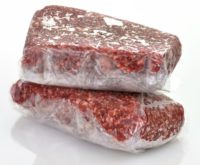Retailers across Europe have reacted quickly to the ongoing horsemeat contamination issue. They have implemented species identification testing programs and removed products including frozen beef burgers and convenience/ready-to-eat meals from their shelves as concern over the origins of the horsemeat escalated.
The detection of horsemeat in beef burgers by the Food Safety Agency of Ireland (FSAI) in January was just the beginning. The scandal spread across Europe, affecting at least 13 countries. Further products, such as Bolognese sauce, lasagna and cottage pie, have also been withdrawn, as product supply lines were found to contain horsemeat.
Food Safety or Food Labeling Issue?
Beef products contaminated with horsemeat have knocked consumer confidence. Sales of frozen beef burgers are down and other convenience foods have also seen a drop in sales. The question for most, beyond the immediate presence of unlisted ingredients in products, is the origin of the horsemeat.
Unlike recent food safety scandals concerning dioxin, bovine spongiform encephalopathy, melamine and dicyandiamide, the detection of horsemeat in convenience foods is not, for now, considered to be a food safety issue. It is understood to be more a fraudulent misuse of the labeling system for economic gain. Misleading the consumer in this way is in contravention of European legislation. Based on Directive 2000/13 as well as Regulation 178/2002, as it is illegal to label a product as beef if another type of meat is present. Europol will coordinate the criminal investigation resulting from this.
“There is no excuse for contaminated beef burgers, but species identification issues are not linked just to horsemeat and beef burgers,” said Rob Parrish, vice president of global food at SGS. “This scandal clearly demonstrates the importance to both the industry and consumers of ensuring that the species a company orders, and pays for, is the species a company receives.”
Equine (Horse) DNA Testing across Europe
Evidence and test results delivered in recently make it clear that this is a European Union (EU)-wide problem, and requires an EU-wide solution. Authorities in the EU have decided that 2,500 tests of processed beef products will be analyzed for horse DNA and will be reported on in April. In addition, 4,000 samples of horsemeat will be analyzed for phenylbutazone, which could take a further 2 months. The EU’s Ministers of Public Health have further agreed that the European Commission recommendation on labeling the origin of all processed meat, should be accelerated and published as soon as possible.
The fear is that horses used previously in for example, sports could have entered the food supply chain. This means that the veterinary drug phenylbutazone, which is a common sedative for horses but has no license for use in horses that have been identified in their passport as not being destined for the food chain, could have contaminated some meat products with potential risk to human health. With this possibility, as well as other questions concerning the origins of the horsemeat, this labeling fraud may develop into a food safety issue.
“Even before this affair demand for species identification on food products has been increasing in the last year,” explained Parrish. “To help clients deliver high quality safe products, that are correctly labeled, SGS is completing the planned expansion of its global capabilities, creating competence centers in Asia, Europe and the Americas.
“SGS has a global network of state of the art laboratories which are equipped and strategically located to provide independent analytical and inspection services. Species detection and identification of species contaminants including pork, beef, horse, duck, turkey, chicken, and seafood can be performed.”
Verifying the Safety of Horsemeat
That horsemeat is being found in the wrong products is without question. The focus of investigation must now turn to how and where it entered the food supply chain, and whether it comes from animals intended for food production purposes.
Food safety analysis to identify medication residues and markers (phenylbutazone “bute,” anti-coccidials and other potentially harmful veterinary drugs) is now being conducted across the continent.
Rebuild Consumer Confidence
“Species identification alone is not the only answer to safeguard against adulterated product entering the food supply chain,” according to Parrish. “Implementing rigorous traceability programs is a must to assure the authenticity of products all through the supply chain.”
To reassure consumers, retailers—who bear the brunt of their concern—must take proactive steps to rebuild consumer confidence. Certification schemes confirm system compliance. However, it may be prudent to take the initiative and ensure traceability and transparency across the food supply chain, with a more rigorous testing program designed to identify issues and deter this type of fraud.
The Good News
In the UK, where early test results have been released, the FSAI has announced that of 3,500 equine DNA tests more than 99% contained no horse DNA at or above the level of 1%.
Ron Wacker, Ph.D., is the global food testing business development manager at SGS. He can be reached at ron.wacker@sgs.com.
SGS’s global network provides supplier audits, product inspection, product sampling as per official methods, mystery shopping and control on sales points to mitigate risks through the food supply chain. Our training services have been designed to improve hygiene and sanitary risk management related to the specific activities of the food industry and help to implement long-term comprehensive food safety systems. www.foodsafety.sgs.com




